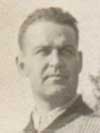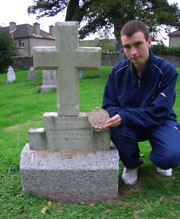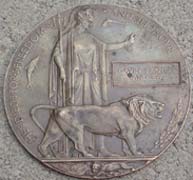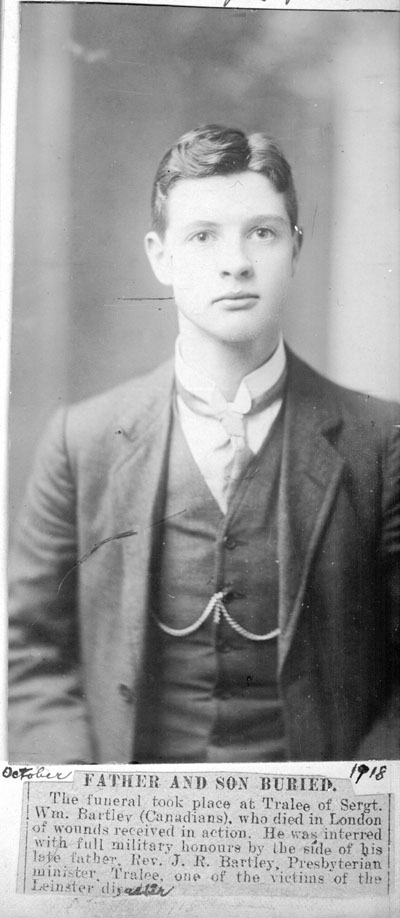| |
The Canadian Connection
Britain's declaration of war in 1914 automatically meant that her
colonies were also at war. Canadian Premier Sir Robert Borden ordered
the mobilization of a Canadian Expeditionary Force (C.E.F.) to serve
in Europe. Men from the Canadian regular army and militia volunteered
to serve, as did thousands of civilians. Among those who joined up
were many from Britain and Ireland who had immigrated to Canada. A
huge mobilization centre was built at Valcartier, Quebec. Here 32,000
volunteers gathered and began training. On 3 October 1914 the CEF
sailed for England in one of the largest convoys ever assembled up
to that time. After further training in England, the 1st Division
landed in Continental Europe in February 1915. The 2nd Division arrived
in September 1915. Both divisions formed the Canadian Army Corps.
The 3rd Division arrived between December 1915 and March 1916 and
the 4th Division in August 1916.
More than 595,000 men enlisted in Canada, of whom 418,000 served
overseas. In all, 258 battalions of the CEF were formed during the
war. Conscription was introduced in the winter of 1917/18, but this
accounted for fewer than 86,000 of the men who served. Canada sustained
210,000 casualties in the war, including more than 56,500 dead. Canadian
soldiers were paid almost 5/- (five shillings) per day, as against
British troops who were given 1s. 2d. (one shilling and two pence).
The Canadians were excellent soldiers. In April 1917 they secured
the first major allied victory on the Western Front when they captured
Vimy Ridge, probably the strongest of the German positions in northern
France. The last allied soldier to be killed in the First World War
was a Canadian. Private Price was shot by a German sniper at 10.58
a.m., two minutes before the agreed cease-fire, while holding flowers
given to him by Belgian civilians.
There were 14 Canadian soldiers and one nurse on the Leinster.
Only five of them survived.
Private Michael Biggane of the Canadian Army Service Corps came from
Bonmahon, Co. Waterford. He was probably among those who joined up
following emigration to Canada. His mother lived in Waterford. So
it was likely that he was visiting her while on leave. The visit cost
him his life. He is buried in Ballylaneen (St. Anne's ) Roman Catholic
Church, Co. Waterford, Ireland.
Lieutenant Donald Gwyn (22), from Sherbrooke, Quebec was a member
of the Royal Canadian Dragoons. The regiment went to France with the
1st Division in February 1915. Gwyn was awarded the Military Cross
for bravery. Having survived the horrors of the Western Front, he
died on the Leinster. He is buried in Grangegorman Military
Cemetery: CE Can. Plot 1, Dublin, Ireland.
Nursing Sister Henrietta Mellett (39) was a member of the Canadian
Army Medical Corps, attached to the 15th Canadian General Hospital.
Mellett was from Co. Mayo and died on
the Leinster. Her death notice in "The Irish Times"
said that she was "murdered by the huns." She is buried
in Mount Jerome Cemetery: 410: A62, Dublin, Ireland.
Captain Edward Milne, on his way for a consultation at a London hospital,
came on board the Leinster on crutches. Known to his family
as Ned, Milne was born in Scotland. His family moved to Galway when
he was six. Later in life he was a junior reporter on the staff of
the Galway Express. Around 1909 he moved to Canada. Joining his brothers
who had already settled there, he went into farming in British Columbia.
On the outbreak of war he and his brothers joined the army. Ned joined
the Mounted Rifles. He later transferred to an Alberta Regiment and
sailed for England on 3 October 1914 as part of the first Canadian
contingent. After further training in England, he landed in Continental
Europe in February 1915 as a private in the 1st Division. He served
on the Western Front throughout the war, rising to the rank of Captain
and being awarded the Distinguished Conduct Medal for bravery. While
recovering from wounds he came back to Ireland. Having survived the
battlefield, he was lost while traveling on the Leinster for a consultation at a London hospital. His body was recovered and
taken to Galway for burial.
There was a Canadian on the Leinster who had recently been
discharged from the Canadian Army. The ancestors of Francis Edward
Higgerty had come from Co. Derry, where their surname was Hegarty.
Francis Edward Higgerty

Francis Edward Higgerty |
Francis Edward Higgerty was born in Ottawa, Ontario, Canada on 22 April 1887,
the son of Henry and Jane (McCormick) Higgerty. He was educated at St.
Patrick's Boys' School and University of Ottawa, Ontario. As a law student
he articled with barrister Edward P. Gleeson, Ottawa, and Hellmuth, Cattanach
& Meredith, Toronto. He was called to the bar 22 September 1913, joined
the firm of Chrysler & Bethune in September 1914 and entered into
partnership with Francis H. Chrysler in November 1915. He was a member
of the Carleton Lawn Tennis Club, Ottawa Rowing Club, Ottawa Reform Association,
Young Mans Liberal Club of Ottawa and National Geographic Society of America.
He enjoyed fishing, skating, skiing, shooting, sliding, and cross country
walking. On 28 March 1918 he joined the 2nd Battalion, Eastern Ontario
Regiment of the Canadian Army. The battalion was an Officer Training Corps
and Higgerty started with the rank of private. He was 5ft 10 ins in height,
had blue eyes, black hair and a ruddy complexion. At some point during
1918 he applied for, and was granted, a commission in the British Army.
He was discharged from the Canadian Army and sailed for England. Before
taking up his commission he decided to visit Ireland. He was among those
who were lost on the Leinster. He is buried in Ottawa (Notre
Dame) Roman Catholic Cemetery: Sec. Z Lot 1677, Ontario, Canada.
Frank Higgerty's great great nephew, Will Lockhart, is the developer
of this website.
Commemorative plaque of Canadian Soldier Sergeant Gavin Francis Andrew
 |
|
 |
| Irish First World War Researcher Conor Dodd at the grave of Canadian Soldier Sergeant Gavin Francis Andrew. He is holding Gavin Andrew’s commemorative plaque. |
|
Commemorative plaque of Canadian Soldier Sergeant Gavin Francis Andrew. |
Father lost on way to visit seriously wounded soldier son
The Reverend John R. Bartley LL. B. (Trinity College, Dublin) of the Presbyterian Church, Tralee, County Kerry was on his way to visit his seriously wounded son when he was lost on the RMS Leinster. His body was recovered and buried on 15 October 1918 in the Protestant Plot, near the main path, in the New Cemetery, Tralee, County Kerry.
Sergeant William Bartley, 150790, 52nd Battalion (Manitoba Regiment) Canadian Expeditionary Force, died of his wounds in a military hospital in Tooting, south London, on 16 October 1918. William Bartley was born on 2 February 1893 at Carnone, County Donegal. He was employed as a bank clerk at the time he enlisted in the Canadian Army on 26 August 1915 at Portage Le Prairie, Manitoba. He was 5 feet 7 inches in height, had dark complexion, blue eyes and dark hair. He is buried in the same grave as his father.
(Grateful thanks to Dave Donatelli for the newspaper clipping with photograph of Sergeant William Bartley).


|
|





